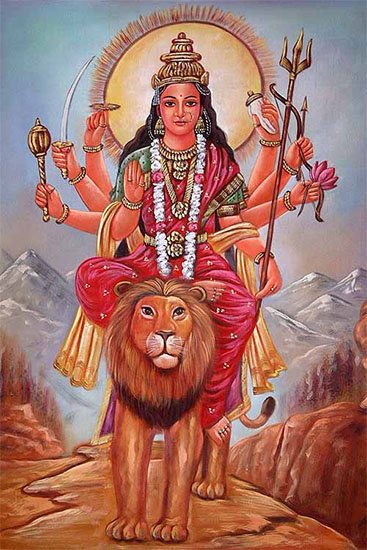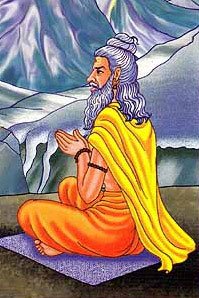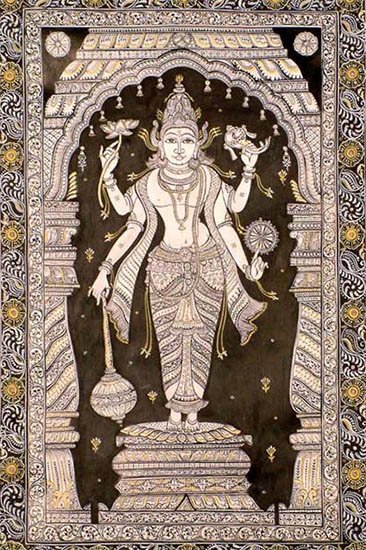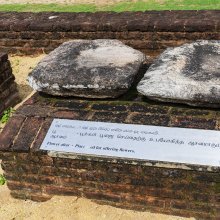Flower: 5 definitions
Introduction:
Flower means something in Hinduism, Sanskrit. If you want to know the exact meaning, history, etymology or English translation of this term then check out the descriptions on this page. Add your comment or reference to a book if you want to contribute to this summary article.
Images (photo gallery)
(+90 more images available)
In Hinduism
Shaktism (Shakta philosophy)
Source: Brill: Śaivism and the Tantric Traditions (shaktism)Worship of flowers formed a part of the Navarātra Tantric ritual (an autumnal festival of the warrior goddess Caṇḍikā).—Worship of weapons with flowers, perfume and food, adapted from the pre-existing Vedic model of military festivities.—Various 5th century sources refer to rituals such as the worship of flowers, for example: Viṣṇudharmottarapurāṇa 2.158.6cd–7, Agnipurāṇa 267.13cd–16ab (repeating Viṣṇudharmottara); Varāhapurāṇa cited in the Kṛtyaratnākara, pp. 364–365.

Shakta (शाक्त, śākta) or Shaktism (śāktism) represents a tradition of Hinduism where the Goddess (Devi) is revered and worshipped. Shakta literature includes a range of scriptures, including various Agamas and Tantras, although its roots may be traced back to the Vedas.
Yoga (school of philosophy)
Source: ORA: Amanaska (king of all yogas): A Critical Edition and Annotated Translation by Jason BirchFlowers (such as jasmines) form part of meditative practices in Yoga, according to the Svabodhodayamañjarī verse 43ff.—Accordingly, [while teaching contemplative techniques]: “One should concentrate on the fragrances of flowers, such as jasmines. Due to having them as its support, the mind also dissolves when they dissolve [...] he is called ‘liberated-while-living’”.

Yoga is originally considered a branch of Hindu philosophy (astika), but both ancient and modern Yoga combine the physical, mental and spiritual. Yoga teaches various physical techniques also known as āsanas (postures), used for various purposes (eg., meditation, contemplation, relaxation).
Purana and Itihasa (epic history)
Source: Shodhganga: Elements of Art and Architecture in the Trtiyakhanda of the VisnudharmottarapuranaFlowers and Rice were coloured and used to create various designs for decorating Mansions or Temples, as part of the “sixty four kinds of Art”, according to the Kamasutra of Vatsyayana.—Cf. the Sanskrit Taṇḍulakusumavalivikāra.—Indian tradition, basically includes sixty four Art forms are acknowledged. The history of Indian Art covers approximately five thousand years which presents a rich and almost continuous record. The references of sixty four kinds of Kala (कला, kalā) are found in the Bhagavatapurana, Shaiva-Tantras, Kamasutra of Vatsyayana etc.

The Purana (पुराण, purāṇas) refers to Sanskrit literature preserving ancient India’s vast cultural history, including historical legends, religious ceremonies, various arts and sciences. The eighteen mahapuranas total over 400,000 shlokas (metrical couplets) and date to at least several centuries BCE.
Natyashastra (theatrics and dramaturgy)
Source: Shodhganga: Elements of Art and Architecture in the Trtiyakhanda of the Visnudharmottarapurana (natya)1) Flowers are denoted by the Sanskrit term Puṣpa, whereas Puṣpahasta refers to one of the thirteen Combined-hand Gestures (in Indian Dramas) (known as saṃyuktahastas), according to the Viṣṇudharmottarapurāṇa, an ancient Sanskrit text which (being encyclopedic in nature) deals with a variety of cultural topics such as arts, architecture, music, grammar and astronomy.—The word puṣpapuṭa is made with two words viz., puṣpa means flower and puṭa i.e., cavity. According to the Viṣṇudharmottarapurāṇa, in puṣpapuṭa posture, both hands are joined together by their sides and the fingers of both hands should be in sarpaśīrṣa position.
2) Flowers (as found in nature) were commonly used for Ornaments (in Sanskrit Dramas), as conveyed through the Alaṃkāra division of Āhāryābhinaya: one of the four divisions of Abhinaya or “ways to convey or represent one’s emotion to others”, according to the Viṣṇudharmottarapurāṇa.—In the Sanskrit dramas ornaments like ear-rings, bracelets, head-gears etc. are seen to be collected from nature. This is informed in many of the Sanskrit dramas. In the Abhijñānaśakuntala, as for example, Śakuntalā is seen to wear flowers, leaves etc. as her ornaments. She is also seen to remain dependant upon nature for her garments. She was wearing the skin of tree as her daily garment. Her clothes were supplied by trees.

Natyashastra (नाट्यशास्त्र, nāṭyaśāstra) refers to both the ancient Indian tradition (shastra) of performing arts, (natya—theatrics, drama, dance, music), as well as the name of a Sanskrit work dealing with these subjects. It also teaches the rules for composing Dramatic plays (nataka), construction and performance of Theater, and Poetic works (kavya).
Shilpashastra (iconography)
Source: Shodhganga: Elements of Art and Architecture in the Trtiyakhanda of the Visnudharmottarapurana (shilpa)Flowers refers to class of natural objects and phenomenon which follows specific guidelines in the tradition of ancient Indian Painting (citra), according to the Viṣṇudharmottarapurāṇa, an ancient Sanskrit text which (being encyclopedic in nature) deals with a variety of cultural topics such as arts, architecture, music, grammar and astronomy.—The Viṣṇudharmottarapurāṇa bears an elaborate description on the process of making the picture of some natural objects and phenomenon, e.g., Flowers. In the context of the spring season in the Ṛtusaṃhāra, the reader can visualise a beautiful picture of nature with trees full of flowers, waters, lotuses, fragrant wind, pleasant evening and delightful days. Thus, the Viṣṇudharmottarapurāṇa addresses various elements of nature, such as a Flower, since painting has much connection with time, mood and activity.

Shilpashastra (शिल्पशास्त्र, śilpaśāstra) represents the ancient Indian science (shastra) of creative arts (shilpa) such as sculpture, iconography and painting. Closely related to Vastushastra (architecture), they often share the same literature.
See also (Relevant definitions)
Starts with (+4): Flower axistree, Flower bud, Flower carriage, Flower Garland Sutra, Flower of paradise, Flower of the andes, Flower of-an-hour, Flower-bed, Flower-fence poinciana, Flower-garland, Flower-pecker fruit, Flower-pendant, Flowering ash, Flowering cherry, Flowering dogwood, Flowering fern, Flowering raspberry, Flowering rush, Flowering spurge, Flowering tobacco.
Ends with (+264): African wonder flower, All day flower, Allegheny monkeyflower, American bellflower, American pasqueflower, Appalachian bellflower, Arctic bellflower, Arizona popcornflower, Asian spider flower, Asiatic dayflower, Balloon flower, Banana flower, Basket flower, Bat flower, Bat-leaf passion flower, Beach sunflower, Bed-flower, Bedstraw flower, Bellflower, Benghal dayflower.
Full-text (+8178): Pushpa, Kusuma, Campaka, Malya, Pushpanjali, Makaranda, Padma, Mallika, Kusumita, Prashuna, Malati, Kesara, Malika, Kunda, Paraga, Palasha, Sumana, Pushpadrava, Abhipushpa, Maranda.
Relevant text
Search found 410 books and stories containing Flower; (plurals include: Flowers). You can also click to the full overview containing English textual excerpts. Below are direct links for the most relevant articles:
The Skanda Purana (by G. V. Tagare)
Chapter 7 - Superiority of Jāti Flower < [Section 5 - Mārgaśīrṣa-māhātmya]
Chapter 4 - Nārada Approaches Padmāvatī < [Section 1 - Veṅkaṭācala-māhātmya]
Chapter 28 - Kriyā-Yoga: Meditation on the Forms of Rādhā and Kṛṣṇa < [Section 9 - Vāsudeva-māhātmya]
The Agni Purana (by N. Gangadharan)
Chapter 202 - Different flowers used in Worship (puṣpa-adhyāya)
Chapter 248 - Benefit of worshipping lord Viṣṇu with flowers (puṣpa-pūjā-phala)
Bhesajjakkhandhaka (Chapter on Medicine) (by Hin-tak Sik)
Medicines (d): Flowers (Puṣpa) < [Chapter 4 - Medicinal Substances in the Chapter on Medicine]
Medicines (a): Roots (Mūla) < [Chapter 4 - Medicinal Substances in the Chapter on Medicine]
Medicines (g): Decoctions/Astringent Medicines (Kasāva/Kaṣāya) < [Chapter 4 - Medicinal Substances in the Chapter on Medicine]
Cosmetics, Costumes and Ornaments in Ancient India (by Remadevi. O.)
1.3. Materials: Flowers < [Chapter 3 - Ornaments]
2.12. Pharmaceutical use of Perfumes < [Chapter 1 - Cosmetics]
2.1. Head Ornaments (e): Paṭṭa < [Chapter 3 - Ornaments]
Kavyamimamsa of Rajasekhara (Study) (by Debabrata Barai)
Part 7.4 - Poetic conventions regarding to the Trees, Plants and Creepers < [Chapter 5 - Analyasis and Interpretations of the Kāvyamīmāṃsā]
Part 7.5 - Poetic conventions regarding to the Trees and Plants < [Chapter 5 - Analyasis and Interpretations of the Kāvyamīmāṃsā]
Part 8.11 - Characteristics of Hementa-kāla (dewy season) < [Chapter 5 - Analyasis and Interpretations of the Kāvyamīmāṃsā]
The Great Chronicle of Buddhas (by Ven. Mingun Sayadaw)
Part 1 - Story of Sumana, the Flower Seller of Rājagaha < [Chapter 21 - Story of Sumana, Aggidatta and Jambuka]
Biography (3) Uppalavaṇṇā Therī < [Chapter 44 - Life Histories of Bhikkhunī Arahats]
Part 13 - The Appearance of Many Miracles on Attainment of Buddhahood < [Chapter 7 - The Attainment of Buddhahood]
Related products
(+55 more products available)











